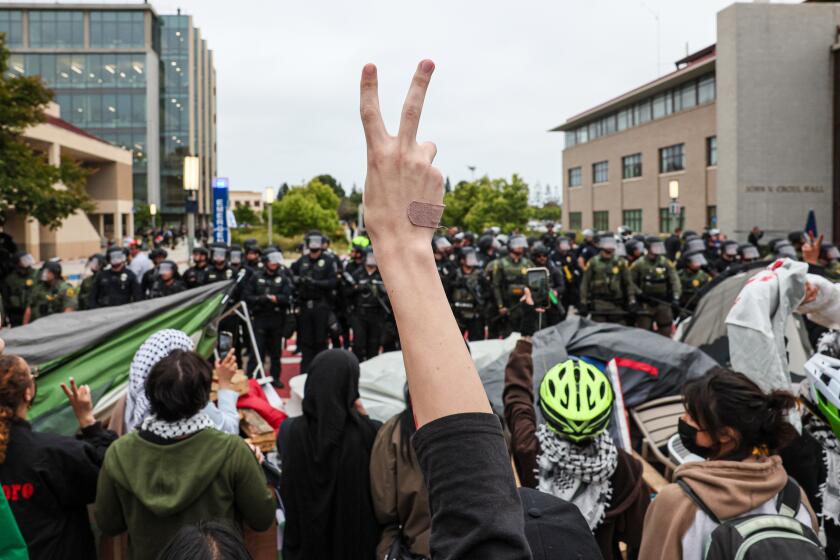Metal recycling firms burgeon in state, but regulators can’t keep up
The explosions came one after another, jolting a South Los Angeles neighborhood.
“It felt like an earthquake, and then it was just raining fire,” recalled Richard Gomez, who watched a metal recycling facility on Slauson Avenue erupt in flames one day in June 2010.
A worker at the United Alloys plant was critically injured in the blaze, which started in a machine that ground titanium into highly flammable flakes. Gomez, who worked at a catering business nearby, said two of his co-workers suffered minor burns when their clothes caught fire.
Noxious fumes kept about 1,000 students at nearby 49th Street Elementary School confined to classrooms without air conditioning for a day.
A month later, fire engulfed another United Alloys building and ignited metal scraps, leading to explosions that sent firefighters flying and showered them with burning shrapnel. Seven were injured.
Fueled by rising world prices for metals, the number of metal recycling operations in California has grown rapidly, far outstripping the ability of regulators to contend with the health and safety risks they pose, a Los Angeles Times investigation found.
Though they commonly handle hazardous materials and sometimes sit in residential neighborhoods, the firms are subject to inconsistent oversight by a patchwork of agencies. Many are rarely if ever inspected.
In some cases, authorities are ill-prepared to handle emergencies. Firefighters in the second United Alloys blaze unwittingly aimed their water hoses at burning titanium, causing an explosion, according to a federal safety report.
In the last three years, at least 23 fires and explosions have occurred at scrap metal facilities in California, according to fire officials, fire department records and media accounts. At least five people have died in workplace accidents and at least 35 have suffered serious injuries, according to the California Division of Occupational Safety and Health. Two of the deaths occurred on the same day in June in separate Central Valley accidents.
Over the same three-year period, at least 20 other people, including firefighters and nearby residents, have required medical treatment for burns, poisonous gas exposure or smoke inhalation caused by accidents, interviews and records show.
Many of the incidents resulted from workers using blowtorches around flammable material or opening metal canisters containing gas.
Other hazards of metal recycling are less visible but more broadly harmful. Toxic dust can be carried by wind and rain onto surrounding property and into the ocean and air.
Local fire departments, regional water boards, the state Department of Toxic Substances Control and theU.S. Environmental Protection Agencyall have authority over aspects of the industry. But no single agency has overall responsibility.
“This whole underground economy has grown up,” said Brian Johnson, the recently appointed head of enforcement for the state toxic substances department. “On the regulatory side, there are so many agencies that potentially can be involved ... and the level of coordination among the agencies has not really kept up with the growth in the industry.”
Johnson said he got a firsthand look at the problem during a recent tour of scrap metal yards in South Los Angeles. “What I saw out there reminded me very much of Third World practices at some of the facilities,” he said.
Scrap metal facilities are usually required to have land-use permits and authorization to discharge runoff into storm drains. Some also need permits for air emissions and to recycle appliances and electronic waste. As a condition for permits, companies agree to meet minimum safety and health standards and in some cases must file periodic reports with regulators.
But many firms skip this process and essentially operate under the government’s radar.
During a 2010 survey, Los Angeles County officials discovered that more than half the scrap metal facilities in the unincorporated Florence-Firestone area of South L.A. didn’t have a land-use permit. SupervisorMark Ridley-Thomashas been pushing unauthorized businesses to get permits — and has succeeded in four of 16 cases so far.
Ridley-Thomas blamed the “inattention of public officials.” But he also faulted “the willfulness of scrap metal owners ... who in some instances go out of their way to disregard even the most commonsensical notions of what is permissible.”
More than 40 scrap metal operators in Southern California do not have required storm water permits, according to a survey by an industry consortium.
Some of the operations have their required permits but skirt the rules. Thirteen scrap operations told the Los Angeles Regional Water Quality Control Board —implausibly — that there was no need to test their runoff for toxic substances, as required, because it hadn’t rained enough over the course of the year to come up with a sample.
“We’re a poor agency, with limited resources for enforcement,” said Sam Unger, executive officer of the water board, which has six inspectors to oversee more than 5,000 industrial facilities and construction sites.
In general, regulatory agencies do not routinely inspect scrap metal sites. They act mainly in response to accidents or complaints.
Some in the industry blame rogue operators for the problems.
“We want to operate responsibly, but the other people don’t,” said Mona Howerton, who helps her husband run Williams Recycling in the Florence-Firestone area. “And they get away with it.”
Others point out that metal recyclers create jobs and new uses for materials that otherwise would end up in landfills.
Scrap metal is “one of the few exports that is contributing positively to our balance of trade,” said Kevin Lawlor, until recently a spokesman for the Washington, D.C.-based Institute of Scrap Recycling Industries, which represents 1,600 companies.
With factories in developing Asian countries hungry for steel and other metals, scrap metal has become one of the largest U.S. exports, worth $7 billion a year in California alone. Much of the cargo moves through the ports of Los Angeles and Long Beach.
The price of steel scrap, for instance, has shot up from $75 a ton in 2001 to about $300 now. Dozens of operations have opened to melt metal down, cut it up and bundle it. Nationwide, scrap exports rose from 6 million tons in 2000 to more than 18 million tons in 2007, according to a federal report.
“We buy scrap,” signs read in English and Spanish along Alameda Street. Some of the operations focus on cars, and others, such as United Alloys, on specialized metals including titanium and tungsten. Most will take in many kinds of metal.
Recycling Unlimited in Wilmington has a typical setup: A small office sits near a mound of metal at least 10 feet high, with box springs, shells of old cars and pieces of rebar poking out at odd angles. Because of patchwork zoning, these businesses sometimes sit right next to single-family homes, some of which are coated in a thin layer of metal dust.
The most obvious dangers are to workers and close neighbors, as was underscored by a succession of accidents in the summer of 2010.
On June 5, a fire broke out at the Pick-Your-Part yard in Wilmington, a car recycler. It took firefighters 30 hours to put it out.
Three days later, at Tulare Iron & Metal in the Central Valley, a worker began to cut up a gas canister without checking to make sure it was empty. Within minutes, a yellow-green cloud of concentrated chlorine gas had enveloped the facility.
“Oh my God, I’m dying,” Beverly Martinez recalled thinking as she staggered out of the office, half-carrying one co-worker while another hung onto her shoulders. She and more than 20 others were injured, six of them hospitalized.
Then came the two fires at United Alloys in South Los Angeles.
Company officials, who had the required permits to operate, declined to comment on either incident.
After the first fire, Cal/OSHA fined United Alloys $6,020, finding among other things that unsafe use of a spark-producing power tool had led to the blaze. The fine was later reduced by more than half.
In September 2010, a fire broke out at Recycling Unlimited in Wilmington. An explosion broke windows at a home nearby and cracked the wall of another, according to neighbors.
Interviewed outside her tidy bungalow, the woman whose wall cracked said there had been explosions on other occasions as well. But the woman, who spoke on condition of anonymity because she feared retribution, said she was more concerned about dirty water that pours from the pile of metal when it rains or the yard is washed.
The company applied for a storm water permit this spring.
In a brief interview, owner Jose Martinez said the 2010 fire “was very minimal ... really quick, no injuries.” He dismissed neighbors’ concerns about water pollution. “When you wash your car, it goes into the storm water too,” he said.
In Southern California, many bodies of water — from the Los Angeles River and Ballona Creek to parts of Santa Monica Bay — are contaminated with heavy metals, causing genetic damage to wildlife and interfering with their reproduction. Although scrap metal facilities are not the only reason, researchers said they are a significant one.
“Do you want to be swimming with automobile waste?” asked UCLA civil engineering professor Michael Stenstrom, who has studied water pollution from scrap metal facilities.
Some companies allegedly polluting on a large scale have been targeted by regulators. Late last year, the EPA accused Sims Metal Management, one of the world’s largest metal recyclers, of polluting San Francisco Bay with lead, mercury, copper, zinc and polychlorinated biphenyls.
Steve Shinn, president of Sims’ west region, said in a statement: “We take any shortcomings of our operations very seriously.... We are working diligently with the EPA to ensure our facility meets both our and their expectations.”
Also last year, Los Angeles County prosecutors and the state reached a settlement with a metal shredding operation at the Port of Los Angeles that had allegedly released an estimated 4.4 tons of material into the air. The reason: A shredder had continued operating for months after an explosion destroyed its air filter.
SA Recycling of Anaheim, which bought the company after most of the violations occurred, agreed to a $2.9-million settlement in September.
In March 2011, state investigators inspected Central Metal in Florence-Firestone in response to complaints from neighbors. They found soil contaminated with PCBs, diesel fuel, zinc and lead, according to their report.
State officials say the company has cleaned up much of its operation and is expected to reach a formal settlement soon.
“We are in compliance with all the environmental issues raised by the regulatory agencies,” said Central Metal manager Jeffrey Byun. “Our industry isn’t the prettiest, but it is a necessary industry for L.A. County.”
Even so, some neighbors say they won’t let their children play outside.
“We cannot open the windows at all,” said Monica Razo, 35. “I wish I had the money to move.”
More to Read
Sign up for Essential California
The most important California stories and recommendations in your inbox every morning.
You may occasionally receive promotional content from the Los Angeles Times.










